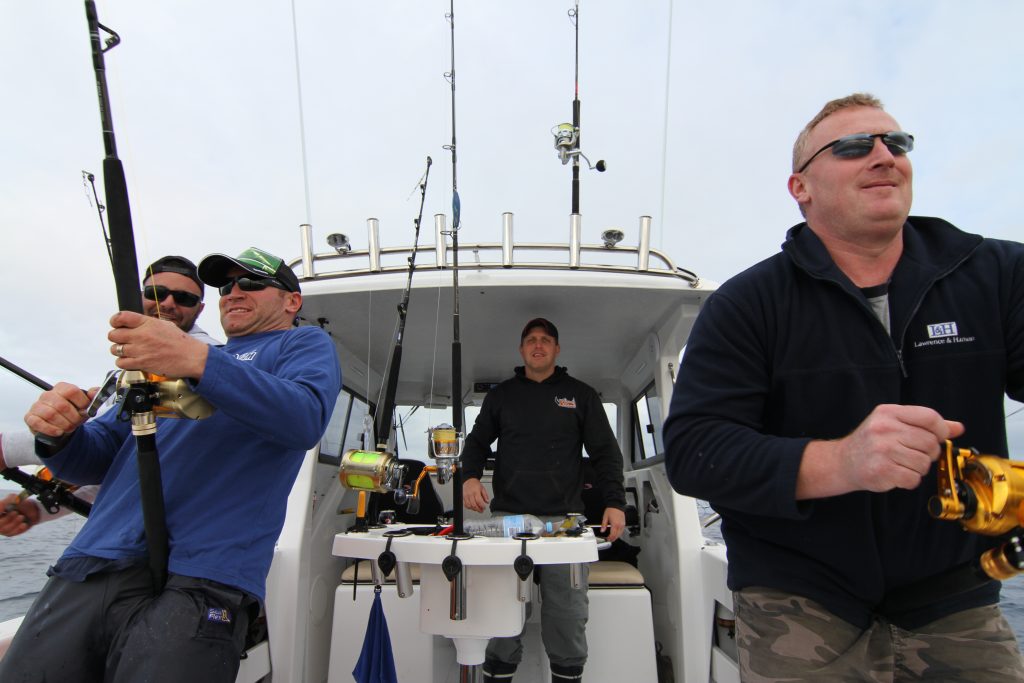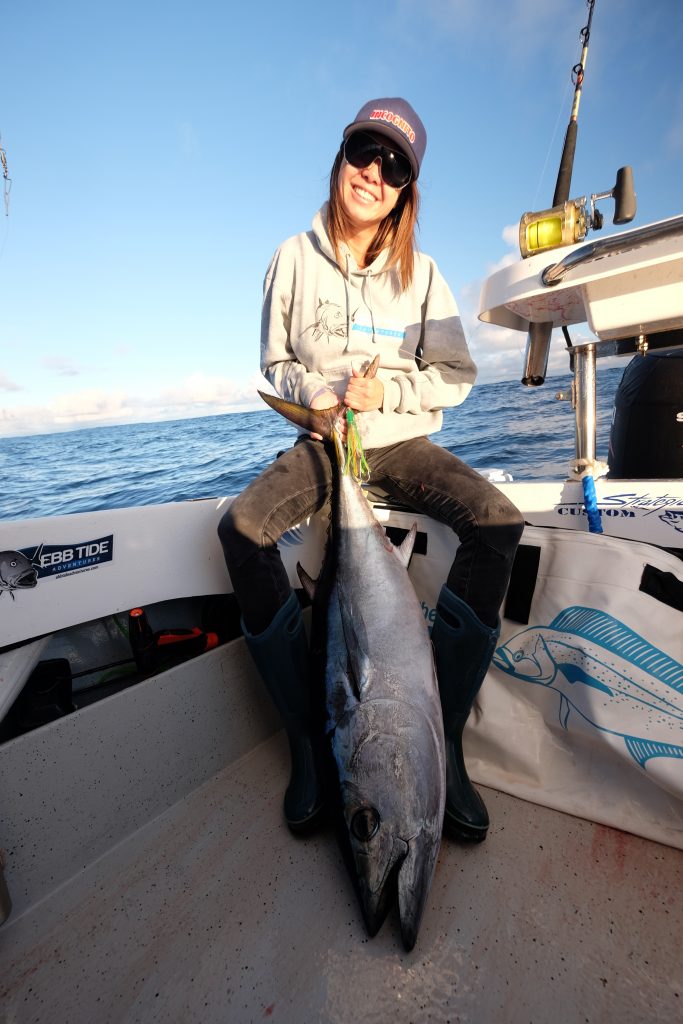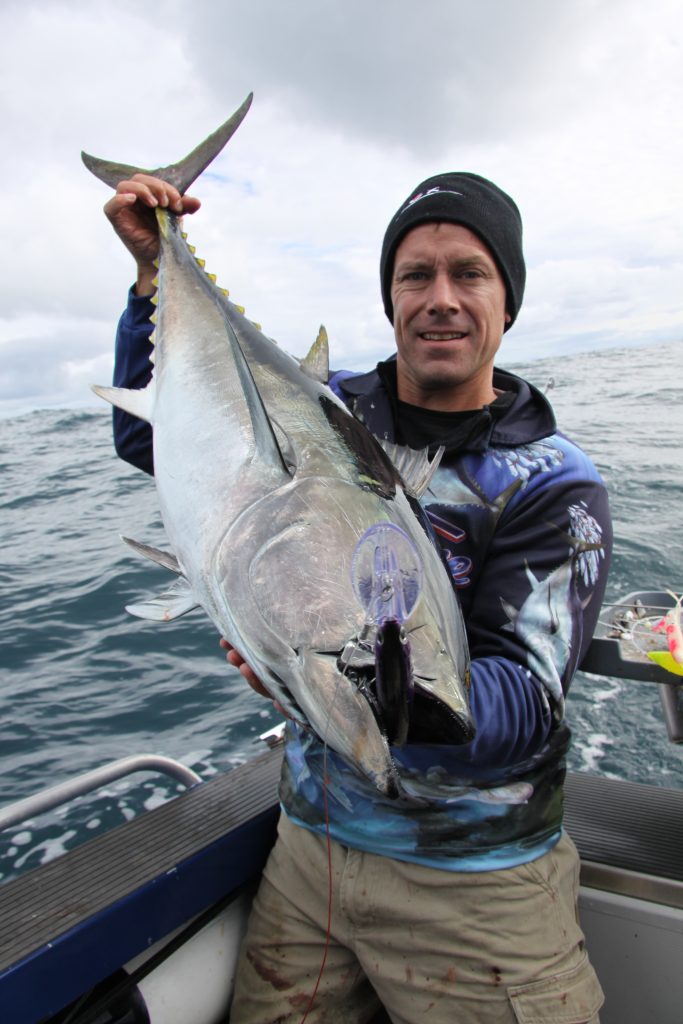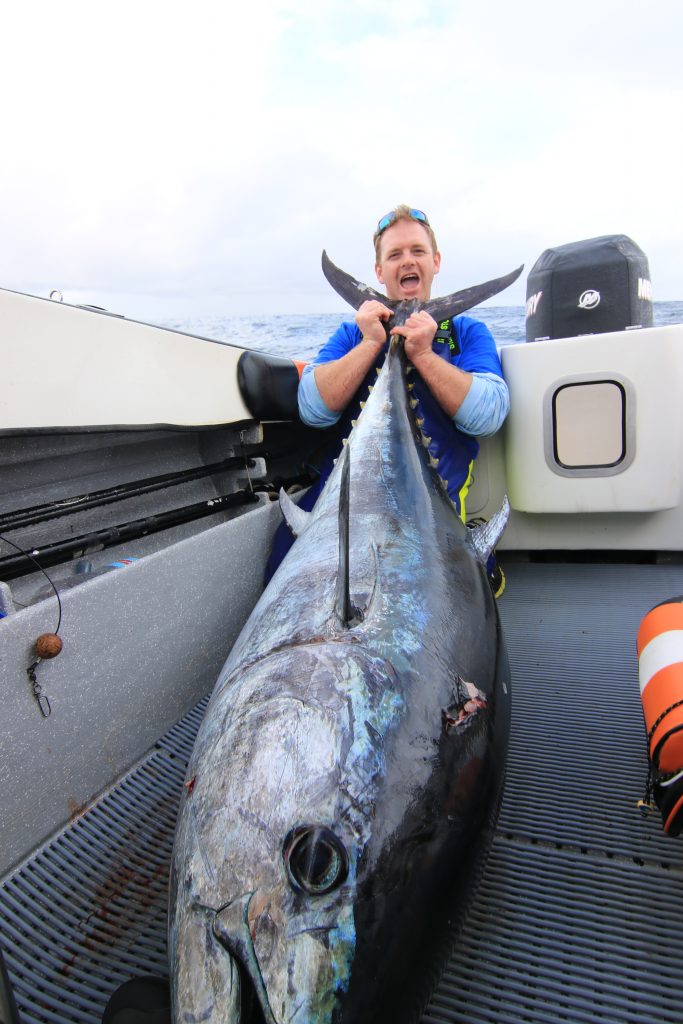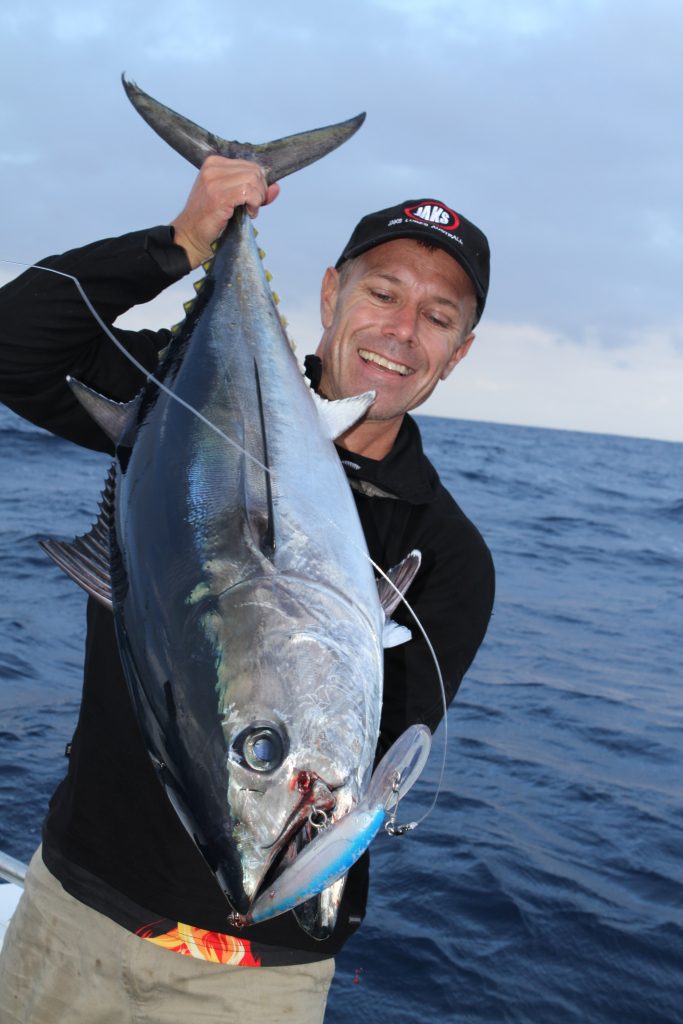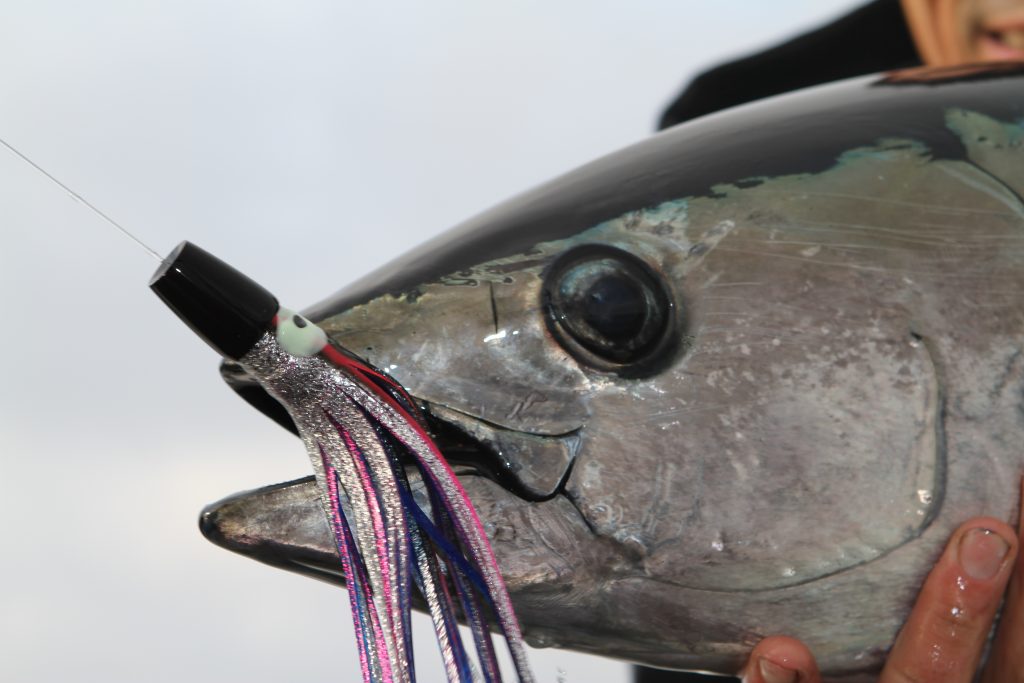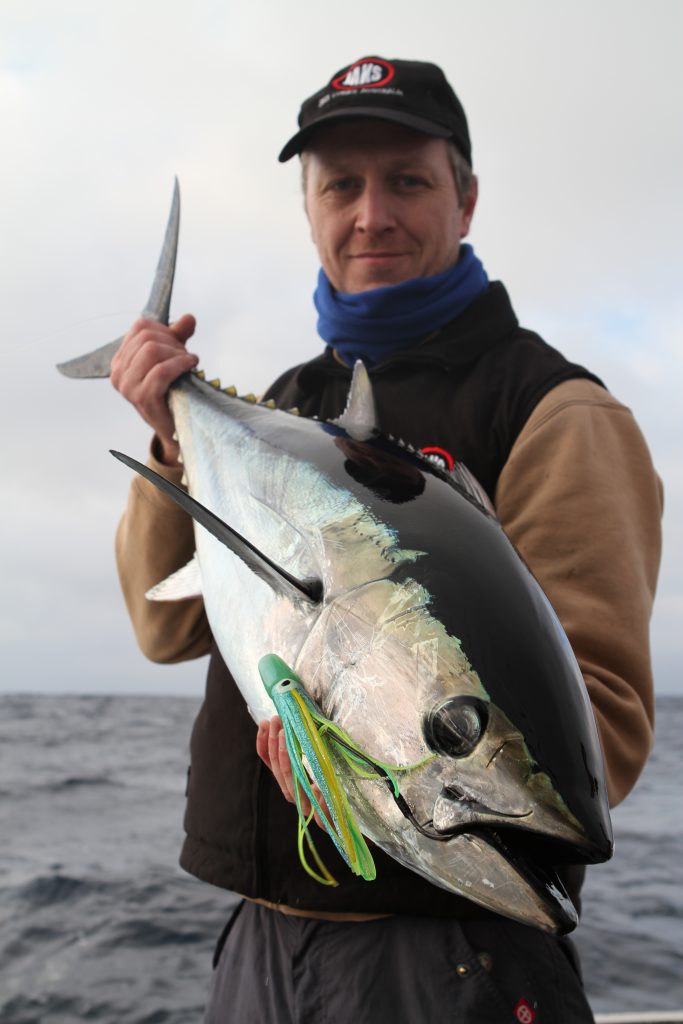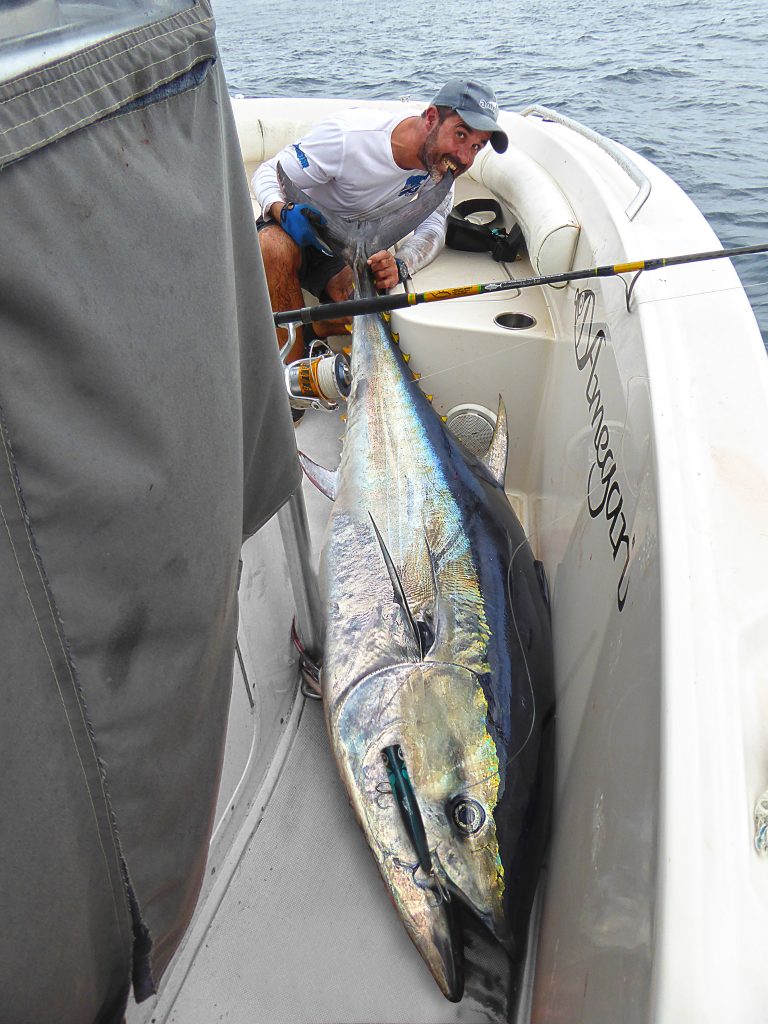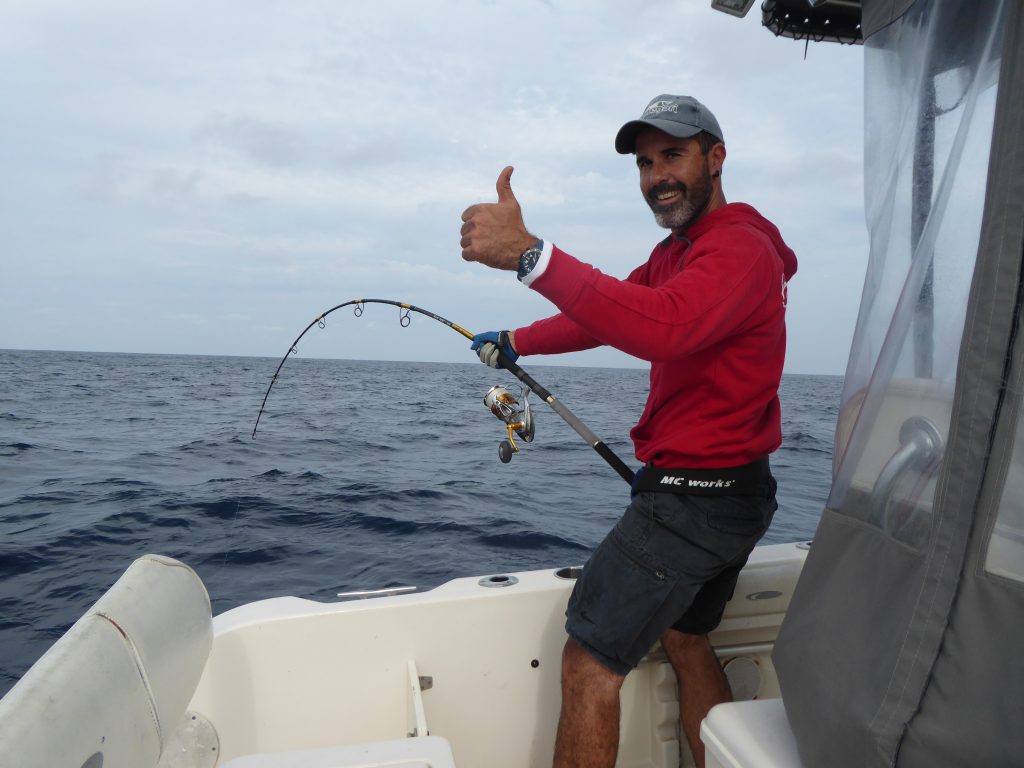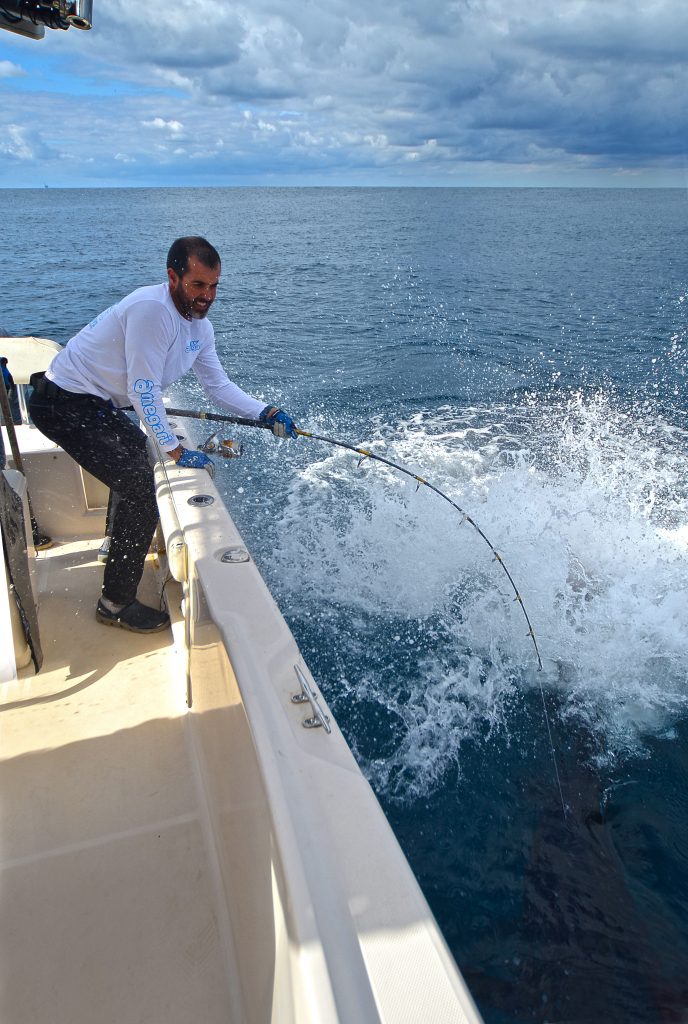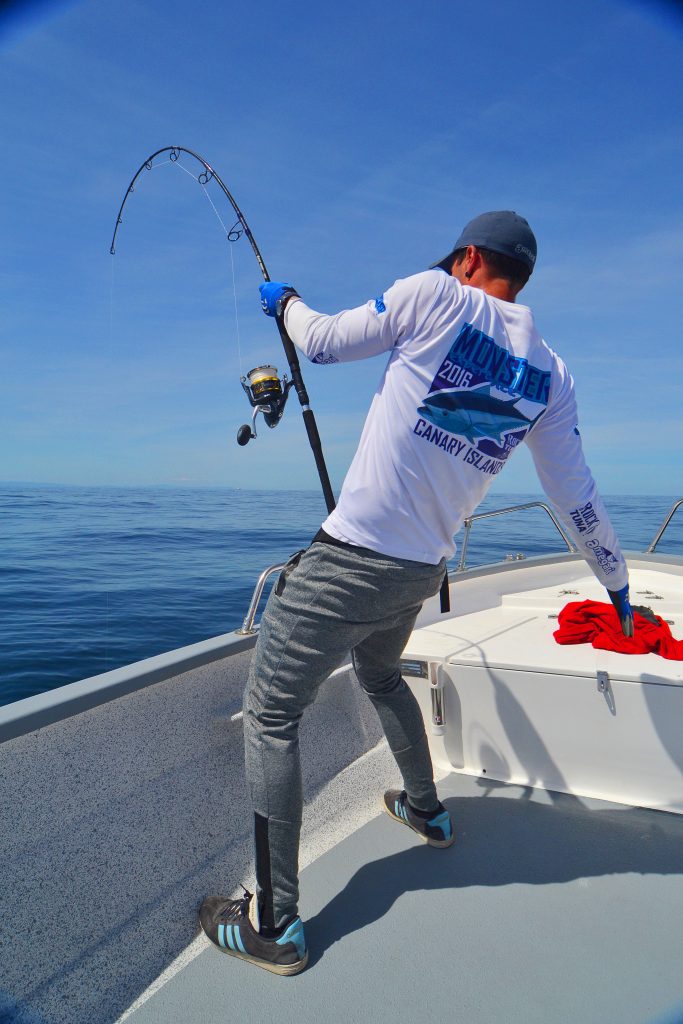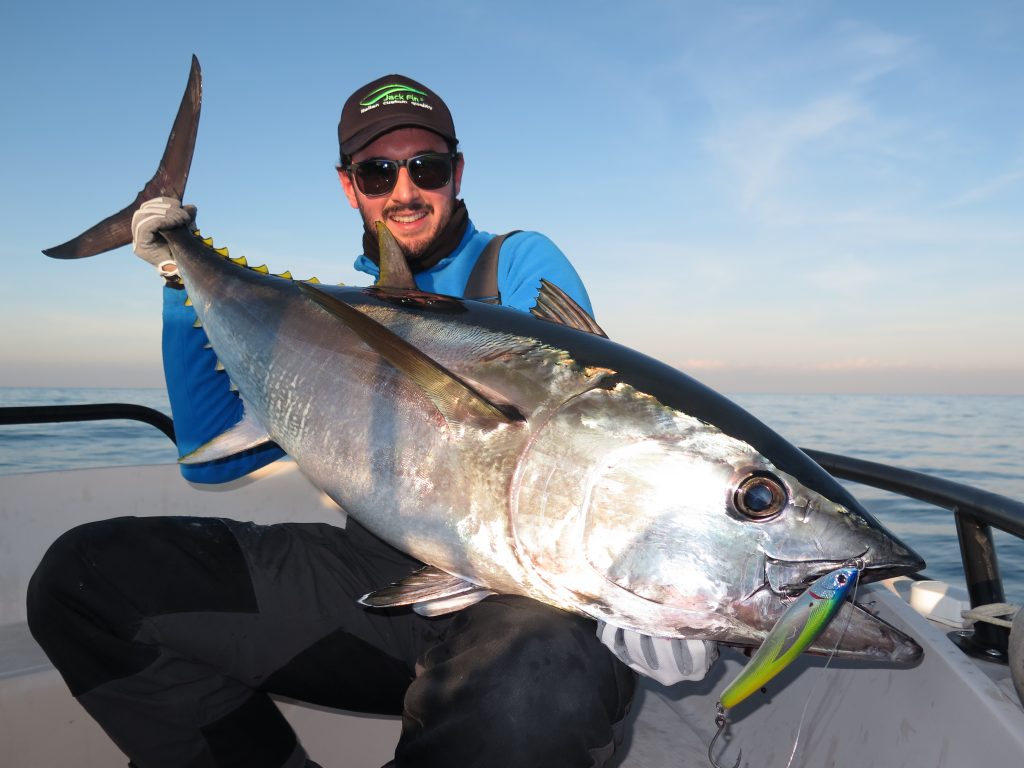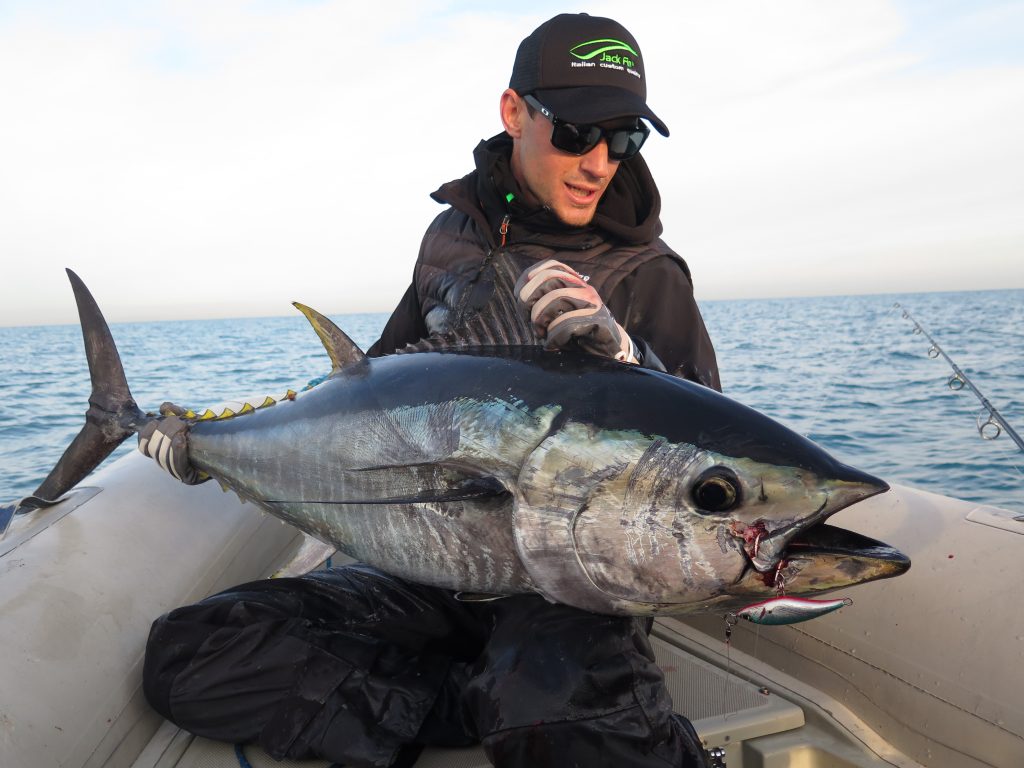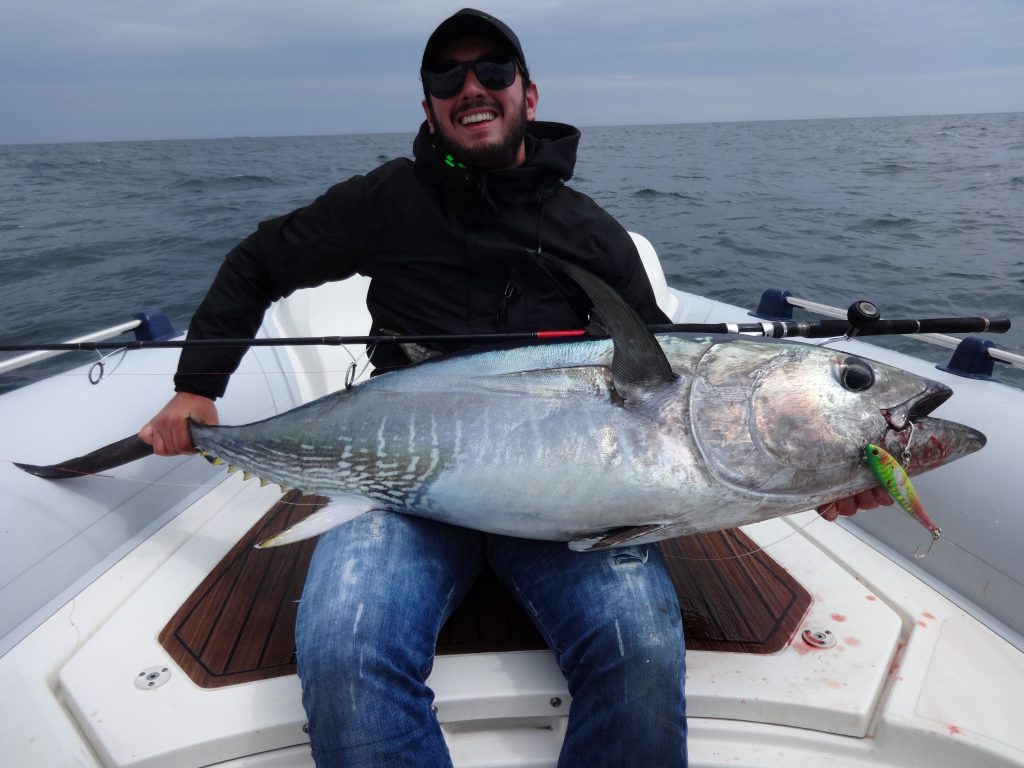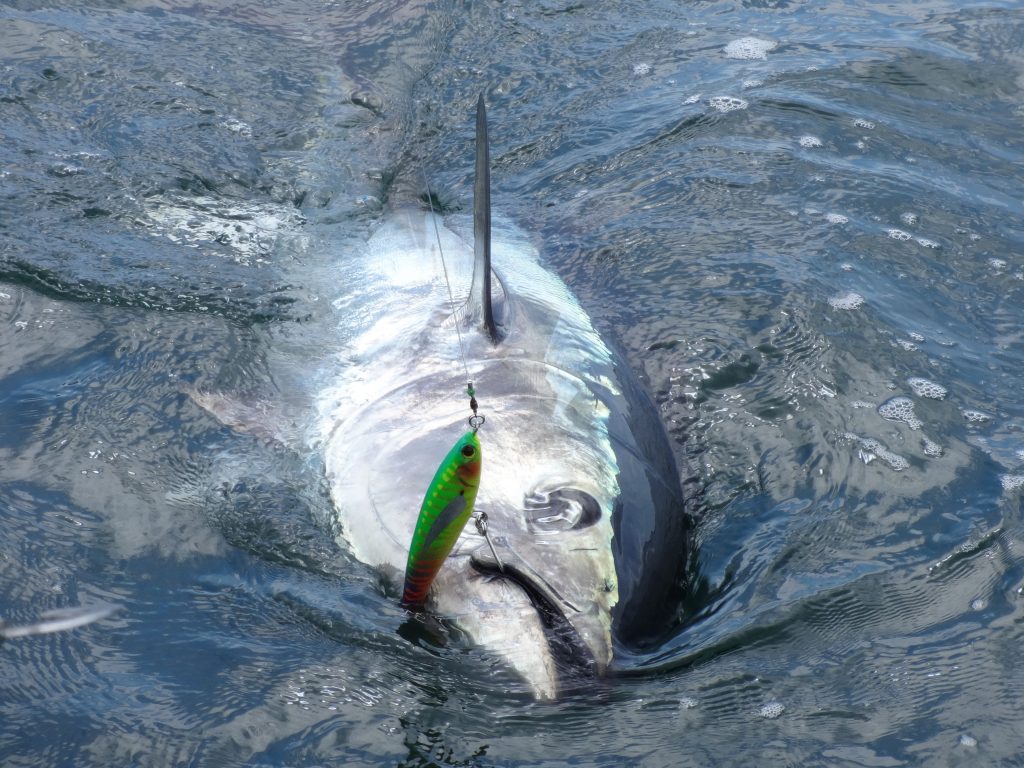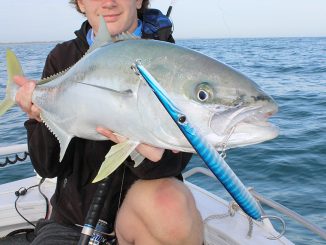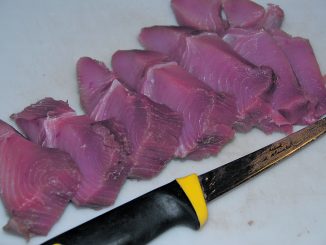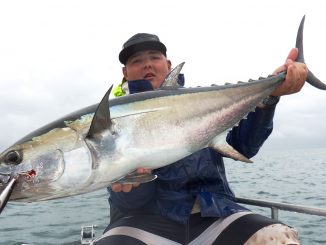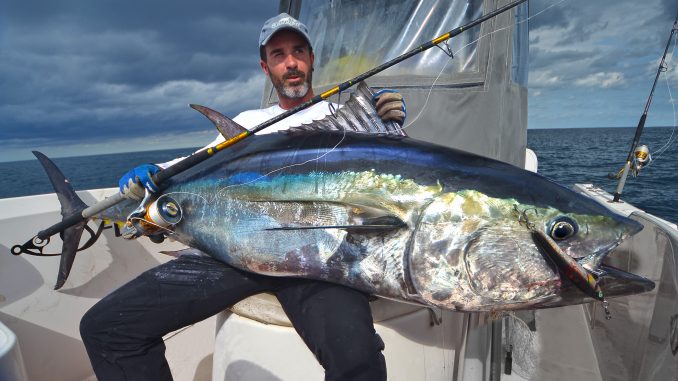
by Andy Smith •
By the time March comes around, anglers have the game gear rigged, the boat given a once-over for offshore use and an eye on the early season tuna reports around the West Coast of Victoria. If that’s you this season, you are late… months late!
The Victorian and Tasmanian southern bluefin tuna fishery has grown from strength to strength over the last ten years. And at the rate things are accelerating over the past couple of years, who knows where this fishery may end up! The vast majority of Victorians who chase southern bluefin head west, to ports from Apollo Bay across to Portland, and also into southeastern South Australian ports such as Port MacDonnell. Don’t discount turning focus to the east of the state later in the season, as there is a little town named Mallacoota that flies often unnoticed…
Early Season
Historically, reports have seen some early fish caught around Portland and Port Fairy, often mixed with schools of yellowtail kingfish. The last two years have seen a solid increase in the numbers of these early fish, usually in water less than 40m depth, which can provide sensational fishing opportunities when the fish are switched on.
Chasing these shallow water early season fish that weigh up to a genuine 30kg can be challenging at times, with the fish pushing into the shallow reef areas close to the coast and a lower abundance of their usual food source of small deep water squid, pilchards and sauries can see these fish switch to a variety of other foods.
If you are tempted to troll skirted lures, a popular method is to downsize the usual lures into models that are under 5” in length.
These fish in shallow water can also be targeted well with cast lures. Stickbaits, poppers with a moderate action and soft plastics can prove deadly. Crucial to this fishing is the use of a great quality pair of polarised sunglasses and the ability to read the water and the bird life in the proximity. Blue mirror lenses are ideal for cutting out bright glare in ocean situations. The ideal tell-tale birds in this situation are terns, feeding on the inshore coastal bait and are renowned for following tuna. Watch for them flying erratically, looking down and bobbing into the water.
If you sight fish cruising, they can often be quite shy and scare easily, especially when in water less than 15m depth. Often, the best approach can be to move ahead of the school, cut your motor and cast a stickbait ahead of the moving school. Ideal lures for this are Jack Fin Pelagus, Heru Wahoo, Lurenzo Don Belone, Amegari Leen, CB One Ozma and Strategic Angler Mikros. Quality lures in this situation can prove the difference on a tough bite. Designed and prototyped for this exact style of fishing, they come into a league of their own.
Marching on
As the season progresses, these shallow water fish don’t draw the same attraction as the ones out wider towards the deep blue. The currents change along the coast and the cold, nutrient-rich water from deep offshore pushes towards the surface and the coastline, bringing with it the ideal food source for southern bluefin tuna. The Portland area is known for being the central hub of a deep water ocean current cycle known as the Bonney Upwelling, created by the southeasterly trade winds that blow in Victoria from November to March.
These winds assist in lifting the nutrient-rich water to the surface from deep offshore and push it parallel to the coastline. This water generally holds masses of krill, providing a superb tuna food source for fish species such as pilchards, cowanyoung, mackerel and sauries and red bait. In addition to these fish species, the waters hold huge numbers of squid, from small squid only a few centimetres long, to fully-grown arrow squid. Squid are a favourite of tuna, and numerous scientific studies show that they make up the vast majority of the southern bluefin diet.
In turn, these areas are where anglers flock. At this time of year, there is a large increase of fishing effort from many anglers. Keeping an eye out for early reports on social media and around the local club, many anglers then hit the road and head west.
The current plays a huge role on choosing the bite locations, with the past several years seeing an ideal situation of great water (with loads of food) being held in relatively close to the coastline (within 10km). The result was great fishing for numbers of tuna and some of massive sizes, with decent numbers of fish over the magical 100kg mark. We can only hope the currents are favourable again. Some key things to look for are the cold temperature edges, or ‘breaks’, along the current line. Also areas where the current slows, eddies or is held will congregate bait and help to attract tuna.
Ensure your boat is up to the offshore waters. These areas can be ruthless and it’s no place for being under prepared. A full suite of safety gear and common sense goes a long way. If you are new to the tuna or game fishing scene, a great way to gain some valuable experience is to either head out on-board with an experienced crew or part with a few dollars to book a charter. There are plenty around and some research will point you towards a quality operation. The quality charter skippers are legitimate professionals in their field and you will be surprised how much information they will share with you if you simply ask questions and show some interest. Don’t simply jump on-board and wait until you get to catch a fish!
Geared to troll
Generally speaking, the fish that are regularly and most often caught are school sized fish from 10-25kg, and while you do not need a boat full of 24-37kg premium range game fishing outfits for these fish, you never know when a monster tuna may decide your lure is on the menu.
Medium-sized game outfits around the 15kg line class bracket are great all rounders for many anglers. If you do fancy your chances on a big fish, then don’t muck around and tempt fate on lighter line classes. There is a fraternity of game anglers out there who specifically target big fish on light line, but this takes many years of experience and dedication. A great all round leader weight for your lures is to use 150lb breaking strain monofilament leader. Brands such as Momoi are famous for superb quality and great value.
Lured in
Tuna fishing in Victoria has a wide variety of approaches that prove effective. Many techniques have been honed and defined, while there are still others that are forging new ground in our waters. We’ll tackle some of these next month in further detail.
The traditional approach of tuna fishing is to troll skirted lures and diving minnows in a spread of up to five outfits. Many anglers have personal preferences of trolling speeds and patterns, but in general, a trolling speed of 5-7 knots is popular. A core element of game fishers that specifically target jumbo tuna will often troll slower than this. Whatever speed you are trolling, make sure it is a speed that your lures are swimming and positioned correctly in your wash.
The ideal location for a ‘swimming’ lure is on the front of the pressure wave behind the boat. This encourages the lure to behave without water and line resistance, allowing the cup of the skirted lure to deliver its designed action. Cupped lures are designed to break the surface, clear some air (termed ‘breathe’) and take it back below the surface. This delivers a bubble trail and wiggle from the lure, encouraging it to swim with action.
Bullet head style skirts are also essential, usually heavy weighted and designed to track straight and below the surface. A deep diving minnow style lure run in the short corner position only 5-10m behind the boat is highly effective, often raising the first bite in a school of fish. Once you hook one fish, it is well worth continuing on for 5-10 seconds as often multiple fish will attack other lures.
The next lure back is termed ‘long corner’ and is positioned on the opposite corner to the deep diver and approximately 5-10m further behind. If you do have outriggers, they are well worth using.
Outriggers provide the ability to widen your spread of lures, allowing the outside lures to swim in clear water outside of the boat wash. Many, many fish can’t resist a lure out here and an added benefit is you can turn in a tighter radius if required. Once again, stagger the distance of these towed lures so your lure spread forms a grouped formation to cover as much water as possible.
The last outfit we need to position is the shotgun, straight behind the motor and back further than all other lures in the spread. Anything over 60m is a common distance for a shotgun lure. There are two schools of thought here, either a small lure that appears isolated and an easy snack, or run a large lure that attracts attention after all the boat wash has settled. Experiment and see what works for you!
Lure size can be a talking point amongst many anglers, but in general, the average length skirted lure trolled by most game fishers is around 6-8” (150-200mm). The use of larger 10” (250mm) and 12” (300mm) lures used to target bluefin tuna in Victoria is growing, and specialist anglers will generally always have a range of sizes in their spread.
Like all fishing tackle, quality lures are not the cheapest but they swim and perform superbly. There are many standout lures, but Jaks Zeus and Barrel Bullet, JB Lures Micro and Small Dingo, Marlin Magic Baby Hard Head, Zuker Feathers and Pakula Lures have long proved extremely productive to have in your tuna spread during the season. Ensure that you have a range of colours, but specifically have a variety of natural baitfish style colours such as evil, red bait and blue dog, along with renowned bright attraction colours such as lumo and grim to accommodate a variety of conditions.
Eyes in the Sky
Birds are the best assistance a game angler can have to find tuna. Put simply, if you find the birds and watch their behaviour, they will often point to tuna. You don’t have to turn into David Attenborough and take off to a remote destination for a research trip, but knowing the main species of birds and their behaviour can be a huge help in the vast blue ocean.
Learn to identify terns, gannets and albatross along with some behaviour patterns and you are ahead in leaps and bounds. You won’t always run into a patch of tuna busting the surface and smashing bait until all that is left is an oily slick on the water. Keep an eye out for any erratic flying behaviour, zig-zagging over one area or continually touching down onto the water. And often, one solitary tern can give the game away for the tuna.
If birds are the eyes in the sky, then seals and dolphins are the pointers in the water. Tuna will feed with these species often. They will regularly work together and hold up a bait school for some easy pickings.
When you pair the natural environment with the latest technology, you are on a winner. Using your sounder to find bait schools, take notice of temperature breaks and searching for bottom ledges and reefs or any feature can be a great start to finding tuna. Often, you will also mark the tuna on your sounder, and there is nothing better than marking fish and then counting down until that reel screams off, or even better, you seeing the lure get eaten!
Tune in to tuna
One of the greatest ways to hone techniques and learn how to catch a tuna is to get out there on the water. Pay attention to the weather forecast, always take the wet weather gear (it is Victoria after all!) and don’t be a sheep. Following a pack of other boats only makes things more difficult, especially if they are driving over feeding schools and not around the edges of them. Remember, the aim of the game is to get the lures near the fish! The more boats that are trying to pull a fish from the one area dramatically diminishes your chances. Trust your instincts, and by all means, use the latest reports, sea surface charts and visual cues out there to get amongst them.
As anglers, the vast majority of us are a curious bunch and from curiosity, knowledge grows. The switched on angler is the curious angler. If there is a way to increase knowledge, the general result is to refine proven techniques, expand knowledge into new realms and for the dedicated, break new ground or begin a revolution.
While the number of anglers diversifying their tactics with alternate techniques to target bluefin tuna across Victoria and Tasmania is growing, there is a worldwide band of fishos that are realms ahead in the journey of discovery.
Worldwide Species
There are three species of bluefin tuna found across the world’s oceans and they are closely related. Other species may grow larger than the southern bluefin tuna we encounter here in Australia (recorded weights up to 260kg), but the pacific bluefin tuna and Atlantic bluefin tuna share many similarities to our local species such as feeding patterns, behaviour and similar tastes for food like pilchards, mackerel, sauries and squid.
It is fairly self-explanatory; the pacific bluefin tuna is found mainly in the North Pacific Ocean, from the east coast of Asian waters across to the west coast of the United States, being recorded occasionally around Australia and New Zealand. Made world famous by shows like Wicked Tuna, these beasts have been caught over 400kg in weight.
The Atlantic bluefin tuna hangs about in the Atlantic Ocean and also the Mediterranean Sea, where numbers of fish appear to be increasing in a similar vogue to the southern bluefin tuna off our coastline. These guys have been known to grow the largest of the three bluefin species, over 450kg, so why not chat to some guys that target these serious large speedsters around Europe and the Mediterranean?
Knowledge City!
I was fortunate enough to have the opportunity to discuss many facets of specific lure casting to big bluefin tuna with two passionate European anglers, who just happen to be lure makers. They’re probably the most hardcore of the hardcore with the detail these guys go into!
Lorenzo Rocchigiani, an Italian that lives and breathes everything fishing-related and co-founder of Jack Fin Lures, kindly provided plenty of input into chasing bluefin tuna on stickbaits. Also more than happy to contribute was Orkatz Aranaz, one half of the hardcore Amegari Lures partnership from Spain.
Between them, these guys (and their lure maker business partners) have spent a huge amount of time targeting tuna very specifically, casting lures to them with significant success. Think of this style of fishing as the ultimate tuna hunt and while the numbers of anglers in Southern Australia are growing, we really only target small school-sized fish or pull the stickbaits out after a few fish.
Patterns
Like all professionals at the top of their game, many similar aspects shine through between both these guys. They both cannot reinforce strongly enough the importance of being geared up for this style of fishing to target serious tuna on the cast.
For their boats, while very different in styles, both anglers have similar requirements, mainly in clear space. Smart, efficient use of space and room is essential, as a cast at no notice is often required and no one wants to stuff a chance at a mega tuna because their rod or reel gets tangled about in the boat’s snapper racks. Lorenzo has a preference for an inflatable boat – a fast, totally open, obstruction-less vessel that allows the anglers to cast freely at 360° and approach the fish activity way more silently, compared to a boat.
Stealth and speed are considered crucial, as Orkatz also highlighted with his preferred 7-8m boat. He likes a centre console if the weather is consistently warm along the tuna season, as it maximises fishing room. A highlight for Orkatz is enough outboard power to run faster than other boats around when it comes to getting there first during a feeding frenzy, coupled with a silent idle engine.
These techniques that both anglers employ are widely known in Europe and the United States as ‘run and gun.’ Time is spent searching for fish and you are always on the hunt. Orkatz regularly covers around 100 nautical miles a day and could not stress enough that you should harness the technology that your boat provides, such as quality plotters and sonar. Read the bird and ocean life. Quality Polaroid sunglasses like the Spotters Nexus Lens assist greatly in finding birds and bait. Orkatz will focus his sounding on fish within the surface feeding zone, with his sonar set to the top 80m.
Lorenzo also focusses on quality electronics, but considers searching by vision as his number-one preferred technique. Employing common blue water techniques such as searching by sight for a feeding frenzy on the surface, signs of bird activity and hunting behaviour or trying to spot water explosions. In his areas of usual effort, the baitfish are quite small and tuna can be very selective on lure size, hunting mostly on schools of little anchovy or sardines.
Orkatz prefers to search at any comfortable speed, often around 8 knots. He also highlighted the need to always search for clues such as birds, jumping or escaping bait. Never forget the sonar and recognise clues such as bait balls and suspended tuna, which usually appear at 20-40m. If Orkatz comes across areas of bait and suspended fish, he will stop and blind cast for at least 15 minutes, as a bluefin will easily explode up to the surface to take your lure from this depth in seconds.
A crucial point is to stay as alert as possible and be the first to reach any bait ball when it rises to the surface. Orkatz believes that if boat traffic is mainly trollers, this is no problem, as they are almost always the first to arrive and get first opportunity at the fish. Once many trolling boats pass over the fish, they are already searching for another opportunity.
Plan and Strategy
Like all forms of specific techniques and focus, a well thought-out plan can provide the basis of learning and success. Orkatz focuses on the general homework that serious blue water anglers all do as a starting point – reports. Find the areas of good water, reported catches or areas of known bait activity. This may be a current or temperature break running along a contour or feature. At least form an idea of where catches have been made.
Then he decides an itinerary for the day, covering the plotter areas they might follow by referring to the currents or recent water movement within the area. A good idea is to refer to historical tuna behaviour and learn the areas where bait tends to stop and accumulate over contours or reefs. This may be the continental shelf drop-off, an isolated bommie in a productive area or an entire reef system on a current convergence. Our coastline provides all of these areas in Southern Australia.
Implement it!
Once the guys find the tuna, all the planning and strategy needs to be implemented, usually fast. Orkatz stresses that when you find tuna feeding on the surface, approach them strategically, first considering the direction they are moving and then the strength and direction of the wind in the prevailing conditions. Use this to allow yourself to cast more comfortably and reach longer distances. A standout point is to always remember objects in the ocean are further than they look, so judge your cast accordingly. Smart use of the boat goes further than the basic position. Use speed drifting as the boat slows to your advantage.
Lorenzo targets serious tuna on the cast in areas often ranging from 25-100m in water depth. He also suggests that it is important to always keep the boat moving and ready to run toward any fish activity. Lorenzo emphasizes that they never employ other techniques such as trolling during the search, as it simply wastes time and removes focus from all eyes searching. A feeding frenzy rarely lasts a long period of time, so as soon as Lorenzo spots the tuna, he will run as fast as he can toward them, slowing down only before reaching cast distance from the fish and letting the boat slide on the surface for the last few metres.
Position
Boat position must be used to provide angler access. Both Orkatz and Lorenzo focus on boat position for the benefit of the anglers. They always try to position the boat with the broadside facing the feeding frenzy, allowing every man on-board an open chance to cast freely without crossing any other angler’s line. At this point, what makes the difference other than good lures is an accurate cast in the fish frenzy and maintaining the lure inside it as much as possible, waiting for the hook-up! For the maximum chance, be where the feeding is focused.
Orkatz highlights dolphins as an important source on the ocean. Dolphins and tuna usually hunt together, so if you see a running school of dolphins, position the boat to cast at the head of the running school. This technique has saved the day on many times with big tuna travelling under the dolphins. He said not to worry, dolphins will not take your lure.
Gear
Casting lures at big tuna requires fairly specific gear. There is always a compromise as longer rods provide longer casting distance, but can have the ability to take leverage from the angler. Modern graphite and blank tapers can enhance performance, giving the angler back the edge. Orkatz singles out rods around 7’2-7’6 in length, that are highly parabolic and with an exceptionally strong backbone. This aids in cast distance, while the parabolic behaviour of the blank minimises the leverage a large bluefin can exert on an angler.
Lorenzo prefers to use longer rods around 8ft in length that can cast lures up to 100g. Both anglers have a minimum preferred breaking strain of 80lb braid (PE8), with Orkatz going even heavier up to 100lb (PE10), along with powerful reels such as the Shimano Stella 18 or 20,000. Reels must be capable of at least 300m of 80lb braid and often drag pressures during the fight may run up to 15kg of pressure. Usual settings while casting and at early stages of the fight are pre-set around 8-9kg. Hit the gym if you want to target the beasts!
Lures and leaders
Both of the guys, being lure makers, obviously prefer their own creations. After all, they have been specifically developed and tuned in their conditions to perform exactly how they require them to. Lorenzo goes straight to the sinking Jack Fin Pelagus 90-S stickbait when the tuna are focussed on small bait such as baby sardines or anchovies. If fish are feeding on mackerel or yakkas, he will go straight to the big brother, the sinking Pelagus 165-S stickbait or the floating Jack Fin Argo 75.
Orkatz usually fishes areas that host larger baitfish and usually prefers lures in the 16-23cm length. His favourite stickbaits are tail down floating stickbaits such as the Amegari Kaxü 215 and Amegari Leen 180 stickbaits. If he’s using a popper, the Amegari Dzanga 160, 180 and Amegari Urpekari 190 are first out of the gear bag.
Orkatz prefers stickbaits with a sweeping action. They have proved effective over many years on tuna and they can usually also be twitch retrieved slow or fast, depending on how active the fish is.
Stickbaits are well and truly proven as a huge favourite of bluefin tuna, but they don’t muck around with a popper. A consistent key with popper design for tuna is to use poppers with a small cupped face and nothing with a booming splash like a GT popper. A great tuna popper tracks in the surface or just below, ideally with some wiggle side-to-side action. Some examples are the Heru Tuna, Heru Skipjack and the Adhek Gecko.
A wide range of stickbaits are available in a variety of forms including floating, subsurface or suspending and also sinking stickbaits. A good sinking stickbait will hold position horizontally and flutter as it falls through the water, just like a wounded baitfish.
When tuna are on the hunt and feeding aggressively, pencil baits are another great option. They are designed to imitate a fleeing baitfish, such as a saury or garfish. These lures such as the Adhek Dragonet and Fisherman Long Pen in relevant sizes will produce plenty of fish on their day.
Leaders are a personal preference and ultimately the only clear differential between the two anglers. Lorenzo prefers to use fluorocarbon leader around 100lb strain for its low visibility and abrasion resistance. Orkatz prefers a rod length or just under shock leader of 130-220lb run off a wind on leader. Orkats dislikes fluorocarbon, as the stiffness and thicker diameter minimises lure action in his opinion.
Both anglers focus on using the boat to assist in the fighting of fish where possible. Use leverage as an advantage to the angler. Many of the large tuna these guys target are released. This is another reason for the heavy gear employed to minimise fight times and provide for a healthy release where possible.
Final Points
Both anglers left me with a standout comment each. Lorenzo told me, “The bluefin tuna is the largest, fastest and strongest predator we have in our sea and in order to fish it we must gear up with high quality and performing tackle. It must be able to endure strong and long pressures and nothing, in this kind of fishing, is left to chance.”
Orkatz’s deep appetite for big tuna shines brightly. “Anglers should be ready with the guns loaded while approaching and cast when they are sure they can’t put the lure past the feeding zone. Bring it to the strike point calmly enough to sweep the stickbait correctly! This is never easy! Usually your chances are few at a big tuna. Don’t miss the only one of the day.”
Casting lures at big tuna is certainly not a new technique, but one that is only beginning to blossom to its full potential in Australia. It is a serious alternate technique to employ. Like any fishing style, it merely requires some focus and planning. Once you experience bluefin tuna on the cast, the surface strike and excitement will leave you hanging on for more. Check out Amegari Lures and Jack Fin Lures on social media for more of their catches from across the world!

